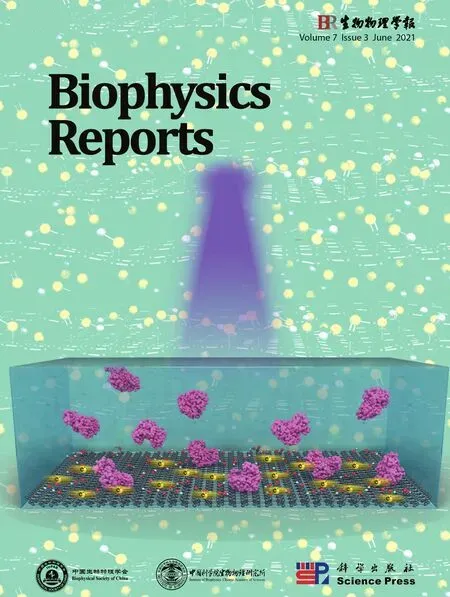Emerging two-dimensional material nanozymes for theranostic nanomedicine
Yanling You,Zhongmin Tang ✉,Han Lin ✉,Jianlin Shi
1 State Key Laboratory of High Performance Ceramics and Superfine Microstructure, Shanghai Institute of Ceramics, Chinese Academy of Sciences, Shanghai 200050, China
2 Center for Nanomedicine, Brigham and Women's Hospital, Harvard Medical School, Boston, Massachusetts 02115, USA
Abstract Nanomaterials-based artificial enzymes (nanozymes) with valuable enzyme-like catalytic properties have been booming during the past few years. Promoted by the advances in biological medicine and nanotechnology, nanozymes possess the potential to serve as an emerging agent for biosensing, immunoassays, detection and diagnosis, catalytic therapeutics, and other applications in the biomedicine field. Two-dimensional (2D) nanomaterials are of considerable interest in biomedical applications due to their ultrathin layered structure and unique physiochemical properties. Inspired by the diversified catalytic performance of 2D nanomaterials, scientists extensively have developed 2D materials as bioactive nanozymes for theranostic nanomedicine. Here, recent advances in enzyme-like 2D nanomaterials design and construction are comprehensively presented. Additionally, we exhibit that, with the synergistic effect of catalytic activities and desirable physicochemical performances, 2D nanozymes can serve as versatile platforms with extensive applications from target detection to in vivo theranostic. It is believed that such promising alternatives towards natural enzymes will be of vital significance in the field of nanotechnology and biomedicine.
Keywords Two-dimensional nanomaterials, Nanozymes, Nanomedicine
INTRODUCTION
Enzyme is a natural biocatalyst related to many physiological processes in living organisms known for its high efficiency and selectivity, which is one of most delicate natural products. However, the intrinsic drawbacks of natural enzymes such as fabrication and preservation difficulties, high cost, poor recyclability and laborious preparation, impede their practice applications in biomedical engineering (Linet al. 2014).Inspired by biomimetic engineering, Ronald Breslow innovatively proposed the notion of artificial enzymes aiming to simulate the catalysis mechanism and process of natural enzyme by using synthetic materials(Breslow and Overman 1970). The rapid growth of researches in nanotechnology brings new opportunities to bionic enzymes owing to the nano-size effect and satisfactory properties of nanomaterials. As early as 2004, Scrimin and co-workers pioneered the term "nanozyme" and opened the door to the favorable integration of nanomaterials and enzymology (Maneaet al. 2004).
Nanozyme is used as an umbrella term for nanomaterials or nanostructures with natural enzymelike properties not only representing a certain kind of material, but a variety of materials combinations (Gaoet al. 2007; Jianget al. 2019; Korscheltet al. 2018; Liang and Yan 2019; Maneaet al. 2004; Wei and Wang 2013).Up to now, a large number of nanozymes have been constructed to exert on-demand highly and tunable catalytic activity in various fields of chemistry, biology and medicine, by promoting the target chemical reaction (Giljohannet al. 2010; Huanget al. 2011; Kimet al. 2009; Luet al. 2009; Sunet al. 2012; Wulff and Liu 2012; Xuet al. 2019). The interdisciplinary concept of nanocatalytic medicine (NCM) was introduced by our group to describe the catalytic therapeutic strategies that the chemical reactions can be triggeredin situto generate or eliminate the corresponding species, and further treating various diseases (Linet al. 2018b; Yangetal. 2019). Notably, nanozymes completely correspond with the emerging perspectives of theranostic practices. Typically, it is well known that the overexpressed reactive oxygen species (ROS) like hydrogen peroxide (H2O2), hydroxyl radical (·OH),singlet oxygen (1O2) and superoxide anion (O2-)contribute to oxidative damage-related diseases(Vander Heidenet al. 2009; Zhanget al. 2021; Zhouet al. 2020). Superoxide dismutase (SOD), peroxidase(POD), and catalase (CAT) in human body are of vital importance in the regulation of ROS contents (Pisoschi and Pop 2015; Sies 2015). By mimicking the ROS scavenging capability of natural enzymes, nanozymes featuring the similar functions can clear the excessive reactive oxygen species, and thus suppressing inflammation (Liuet al. 2020; Qinet al. 2020; Wuet al.2021), preventing neurological injury and aging-related diseases (Baoet al. 2018; Kwonet al. 2018; Singhet al.2017),etc.
Exploring the structure-activity relationship towards nanomaterials and/or nanostructures has been a longheld goal for materials science. Novoselov and Geimet al.reported the first experimental prototype of twodimensional (2D) single-elemental atom crystalgraphene in 2004, opening a new era of twodimensional materials (Novoselovet al. 2004). Since ultrathin 2D topologic confinement, electrons in nanosheet could only enable to move freely on the nonnano scale inside planar dimension, which endows 2D materials with unique electrical characteristics and excellent physicochemical properties (Gopalet al. 2020;Zhang 2015). In recent, 2D nanomaterials and their potential applications in catalysis and electric industry have been widely discovered, arousing explorations of which to serve as nanozymes (Denget al. 2016). In addition, owing to desirable biocompatibility and biodegradability, 2D nanomaterials hold great potential in the field of biomedicine (Chenget al. 2020; Wang and Cheng 2019). Based on exceptional catalytic activity and potentials in future clinical applications, 2D nanomaterials have been reported to exhibit stimuliresponsive and multi-enzyme mimetic activities (Chenet al. 2018; Chonget al. 2016; Gaoet al. 2020; Liuet al.2021; Renet al. 2019; Shanet al. 2019; Songet al. 2010;Yimet al. 2018). In general, the designable 2D nanomaterials represent a next-generation artificial nanozymes for the unique applications in some specific niches.
Despite the rapid development of 2D nanomaterials,few studies have specifically summarized its applications as nanozymes in the field of biomedicine.To highlight the value of 2D materials in the fields of biology and medicine, this review discusses the endeavors on developing promising enzyme-like twodimensional nanomedicine. We also introduce the latest multifunctional 2D nanozymes and present how they transform their own enzyme-like activities under the activation of the external environment to enhance the therapeutic efficacy for different diseases. Finally, we come up with future perspectives of nanozyme development with a view to improving the discipline system of "nanozymology" and promoting their practical applications (Fig. 1).
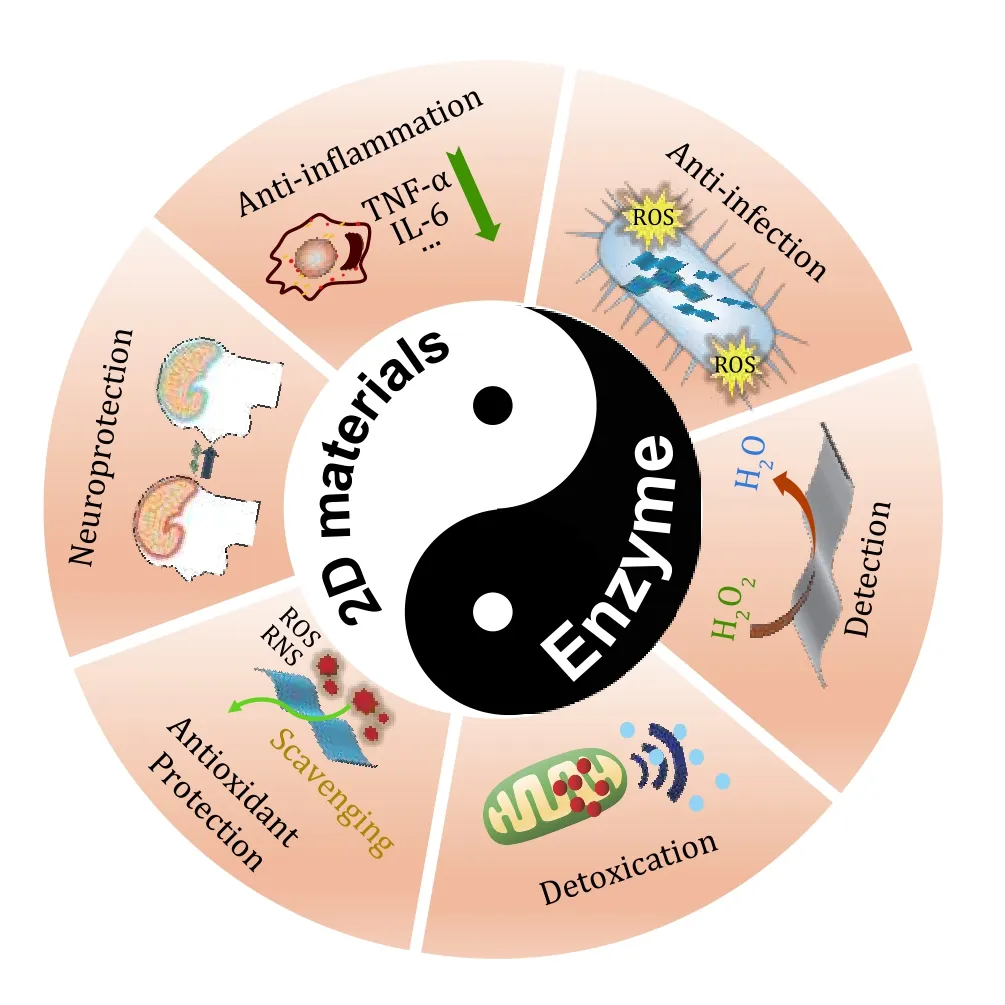
Fig. 1 Schematic illustration of emerging two-dimensional material nanozymes for theranostic nanomedicine
TWO-DIMENSIONAL NANOMATERIALS AS NANOZYME FOR BIOMEDICAL APPLICATIONS
2D nanomaterials such as graphene, MXene, transition metal dichalcogenides (TMDs), black phosphorus,layered double hydroxides (LDH), and layered metal oxides, are of increasing attention for their intriguing physiochemical properties (Linet al. 2018a; Zhang 2015). Surprisingly, the past decades have witnessed growing interest in developing advanced 2D nanomaterials featuring the mimicking potential of natural enzyme functions due to their high catalytic performances. In this section, we will introduce design concepts for multifunctional 2D nanomaterials of enzyme-like activity and their biomedical applications.
Graphene and derivatives-based nanozyme
Graphene is the most representative 2D nanomaterials endowed with unique electronic, optical and other physicochemical properties, which has been widely investigated in nanomedicine and biomedical engineering (Geim and Novoselov 2007). Duo to the lack of catalytic activity, pristine graphene is inadequate to be an artificial candidate material as nanozyme (Guo and Dong 2011). Nevertheless, it provides new opportunities like a few carbon-based nanomaterials including graphene oxide (Songet al.2010), fullerene (Krotoet al. 1985), carbon nanotubes(Cuiet al. 2011) and carbon nanodots (Chonget al.2016) have been found to possess enzyme-like activity.In specific, upon doping or modification, graphenebased nanomaterials can exhibit biocatalytic functions similar to oxidase, catalase, superoxide dismutase,etc.(Boutorineet al. 1995).
In 2010, Songet al.reported that carboxyl-modified graphene oxides could catalyze the reduction of H2O2,which demonstrated intrinsic peroxidase-like activity derived from carboxyl-modified graphene oxides noted as GO-COOH (Songet al. 2010). To take advantage of the enzyme-like activity, they designed a colorimetric method for H2O2and glucose detection. In the presence of H2O2and peroxidase substrate 3,3',5,5'-tetramethylbenzidine (TMB), GO-COOH can change TMB absorbance at 652 nm by a blue chromogenic reaction (Fig. 2A, 2B). Given that the catalytic activity of GO-COOH is relative with H2O2concentrations, it is feasible for GO-COOH to detect H2O2. In addition, by detecting hydrogen peroxide, the product of the glucose oxidase catalyzed reaction, a simple and rapid detection of glucose was successfully developed. The detection activity of GO-COOH was regulated by acidic pH,reaction temperature, and hydrogen peroxide concentration, and the optimal conditions were of pH 4.0, 35.8 °C, and 150 mmol/L after systematic assessment. It could be found that the catalytic activity of GO-COOH towards TMB superior to that of natural enzyme horseradish peroxidase (HRP) under the optimum conditions. As the Fig. 2C shows, the GOCOOH nanozyme presents highly selective and sensitive detection performance of glucose in buffer solution,dilute blood and fruit juice. H2O2detection is of great significance in the fields of biology, medicine,environmental protection, chemical industry and food engineering. Inspired by the participation of H2O2in the catalytic reaction of peroxidase, the concentration of H2O2can be detected selectively by the color reaction of peroxidase-like nanozymes with certain colorimetric substrates. More importantly, the designing concept is not limited to H2O2peroxide detection. Such study provides a new insight into applying nanozymes in targeting detection and diagnosis.
In order to further promote the applications of graphene, scientists have developed various methods to convert 2D graphene to 0D graphene quantum dots(GQDs). As a typical structural derivative of graphene,quantum dots are of strong photoluminescence property which is essential to several applications like bioimaging or photovoltaics. Additionally, the photoluminescent GQDs could react with either electron acceptor or donor, and subsequently be quenched, which may serve as an emerging free radical scavenging nanoagent. For instance, Chong and coworkers discovered that graphene quantum dots have ROS-regulation function that GQDs could perform superoxide dismutase-like activity to downgrade ROS levels, while generating ROS to produce phototoxicity upon exposure to blue light (Fig. 2D) (Chonget al.2016). This exceptional Janus-like ROS-regulated performance simultaneously enables GQDs with oxidative stress relieving capacity and antibacterial or anticancer efficacy. Based on desired antioxidant activity, they explored the effectiveness of GQDs protecting cells from oxidative damagein vitroandin vivo. The cell experiments indicated that the GQDs remarkably improved the survival rate of H2O2and X-ray damage cells (Fig. 2E, 2F). Furthermore, they found that under the exposure of light, GQDs showed completely opposite effect of ROS regulation performance that GQDs elicit phototoxicity under the 405 nm laser irradiation by generating ROS and further inducing cell apoptosis (Fig. 2G). What's more, GQDs could accelerate the inactivation of anti-oxidase in body. This research developed a light-activatable nanozyme and demonstrated the artificial nanomaterials of diverse bio-functions through conditional activation. Since most 2D nanomaterials are known to feature photoelectric characteristics, it is of great significance to develop stimuli-responsive smart nanomedicine based on diverse 2D nanomaterials.
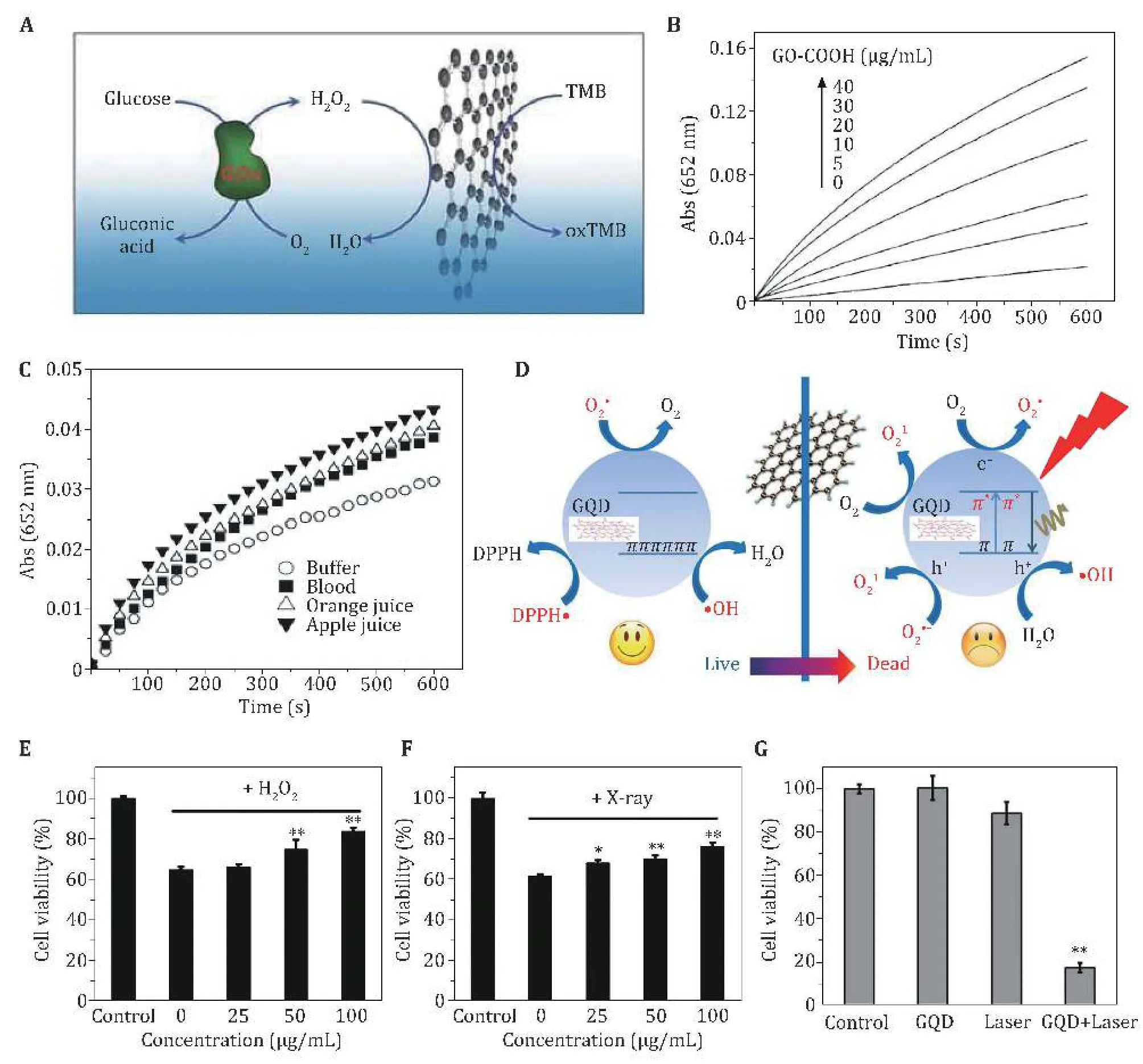
Fig. 2 Graphene-based nanomaterials as nanozymes for detection and therapy. A Illustration of GO-COOH serving as a peroxidase mimic for glucose detection. B The absorbance change curves of the TMB oxidation reaction catalyzed by GO-COOH with varied concentrations. C The absorbance change curves for various samples. Reproduced with permission (Song et al. 2010). D Schematic diagram of GQDs with light-dependent ROS-regulated activity. Cell viability of HUVECs damaged by H2O2 (E) and X-ray (F) under the antioxidant protection of GQDs with varied concentrations. G GQDs showed completely opposite effect of ROS regulation performance under the exposure of light. Reproduced with permission (Chong et al. 2016)
Two-dimensional (2D) transition metal oxides(TMOs) -based nanozymes
During the past few years, transition metal oxides(TMOs) have received great attention and spurred a range of research efforts. 2D TMOs nanosheets with specific mixed valence, desirable conductivity property,abundant redox combinations, and thermal stability have attracted current interest in various applications such as photoelectric catalysis, sensors, and electrochemical energy storage (Haqueet al. 2017; Leeet al. 2018).
Vanadium is a transition metal. It is widely believed that vanadium pentoxide (V2O5) is the toxic compound,which is an oxidant and a common component in PM2.5(Dillet al. 2004). Interestingly, a great deal of novel properties is emerging as materials are being decreased to nanoscale. V2O5materials at nanoscale show completely opposite characteristics. For example, a biocompatible nanozyme based on V2O5nanowires with remarkable glutathione peroxidase (GPX)-like activity was developed for performing ROS scavenging and serving as cytoprotectant against harmful oxidative damage (Vernekaret al. 2014).
Recently, a few investigations have reported that reactive oxygen species (ROS) levels are associated with the replication of human immunodeficiency virus (HIV-1) after infection. Cellular antioxidant machinery has been demonstrated to contribute to the acceleration of HIV-1 reactivation during HIV-1 latency (Diazet al. 2019;Shytajet al. 2020). In order to neutralize ROS in HIV-1 infected cells and inhibit viral reactivation, Singhet al.used V2O5nanosheets (Vs) as glutathione peroxidaselike nanozyme, which is the pioneering therapeutic strategy against HIV infection (Fig. 3A) (Singhet al.2021). In 2018, Ghoshet al. found that the enzymemimetic activity of V2O5was dependent on the reactivity of V=O bond and exposed facets on the surface rather than the morphology (Ghoshet al. 2018). A comparison of activities and toxicities of V2O5in three different morphologies,i.e., nanowires, nanosheets, and ultrathin nanosheets was conducted by Singh and co-workers. As a result, they found that ultrathin V2O5nanosheets were selective toward H2O2with high efficiency and the most secure, which also confirmed the unique superiority of 2D nanomaterials in biomedicine applications. As shown in Fig. 3B, the viral RNA levels from Vs treatment groups were obviously lower than the groups of ARVs(antiretrovirals) alone at Day 21. Meanwhile, V2O5nanosheets could also suppress viral reactivation stimulated by prostratin and bolster the antiviral capacity of immune cells. It is a great discovery that oxidative stress which changes redox signaling promotes the reactivation and multiplication of HIV-1,revealing the relationship between redox metabolism and disease outcomes. These advances together offer a novel therapeutic potential for the HIV-1 adjuvant therapy of diverse antioxidants especially nanozyme.The satisfactory glutathione peroxidase (GPX)-like activity of V2O5nanosheets may encourage new applications to treat other critical illness with redox imbalance.
Black phosphorus nanosheet-based nanozymes
Black phosphorus nanosheet (BP NS) marks an omnipotent, rising-star nanomaterial with unique properties. Remarkably, BP is also a promising candidate in the multidisciplinary biomedical field due to its good biocompatibility and excellent biodegradation. In the past few years, BP exhibited considerable photothermal therapy (PTT) and photodynamic therapy (PDT) efficacies (Wanget al.2015). In recent, researchers have been focusing on the enzyme-like activity of BP, owing to its prior chemical reactivity with ROS. This finding introduces BP as a new species of nanozyme for anti-oxidant related diseases therapeutics.
As stated, acute kidney injury (AKI) as a severe illness leading to loss of renal function is largely caused by drugs administration in chemotherapy. In the process of the renal excretion of chemotherapeutic drugs, massive ROS generate and damage renal cells. In order to relieve AKI and protect the renal function, Houet al. prepared a black phosphorus-based anti-oxidative nanoagent for kidney targeting and ROS neutralizing(Fig. 3C) (Houet al. 2020). It has been reported that flake-like DNA frameworks have ability to kidney targeting drug delivery (Jianget al. 2018). The same geometrical framework endows BP NSs with passive targeting to kidney, and the biocompatible nanosheets can degrade into nontoxic phosphorus oxides and/or phosphates. Most importantly, BP NSs display fascinating performance without any sophisticated modifications which facilitates their ultimate clinical translation potential. The blood biochemical indexes of renal function including serum creatinine (CRE) and blood urea nitrogen (BUN) elucidated that the BP NSs are an effective therapeutic antioxidant as a SOD mimic for AKI treatment (Fig. 3D, 3E). Notably, the outstanding biocompatibility and biodegradability of BP NSs promote the further translational research on such a promising 2D nanozyme for AKI treatments.Furthermore, thein vivoimaging diagnosis shows great value in real-time monitoring for AKI (Wanget al.2021). 2D nanomaterials-based contrast agents are also expected to provide multiple applications in diagnosticimaging fields, which will allow innovative theranostics in AKI.
Growing evidence suggests that the elevation of transition-metal ions is the main cause of many neurodegenerative diseases (Barnham and Bush 2014;Jun and Saxena 2007). Except for ROS scavenging, BP NSs may also aid in the regulation of metal ions such as Cu2+for neurodegenerative disorder treatment. For example, Chenet al. used BP NSs as a neurodegenerative disorder therapeutic agent which can cross the blood-brain barrier (BBB) and capture excess redoxactive Cu2+(Chenet al. 2018). Notably, their work exhibited a synergistic therapeutic strategy that BP nanosheets could effectively enhance the blood brain barrier penetration due to local hyperthermia taking advantage of the high photothermal-conversion efficiency (Fig. 3F). Subsequently, BP nanosheets as neuronal cells protector enables to downgrade the cellular Cu2+level and eliminate ROS. Thus, it is believed that black phosphorus nanosheet will be applied as a SOD-like nanozyme which may perform multifunctional nanodrugs rather than just conduct ROS scavenging.
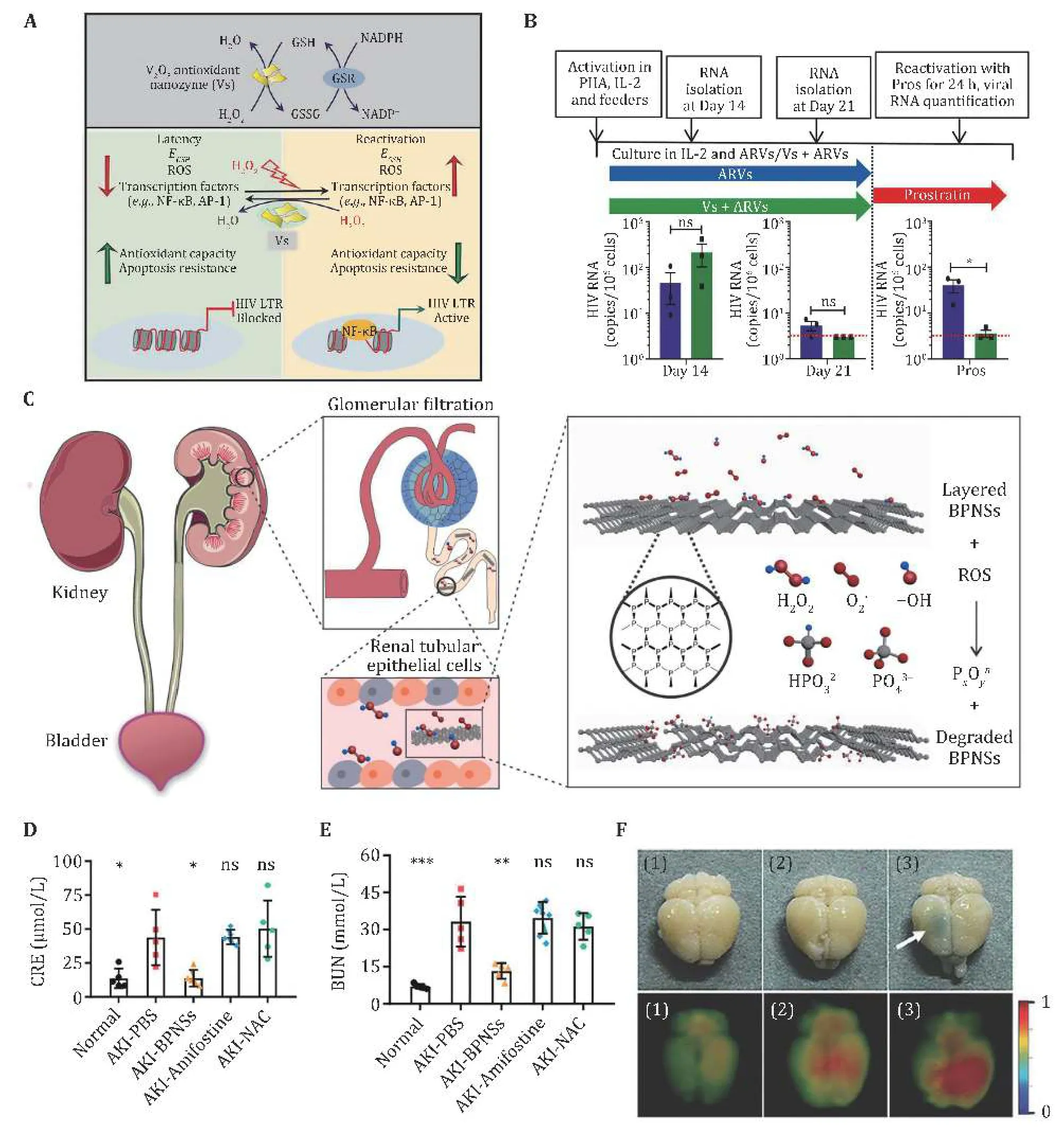
Fig. 3 Antioxidant nanozyme for various diseases treatment. A Schematic illustration of V2O5-based nanozymes for anti-HIV-1 infection. B The activation of viral transcription in CD4+ T cells from three HIV-1-infected patients in the treatment of V2O5 nanosheets. HIV transcripts measured by RT-PCR. Reproduced with permission (Singh et al. 2021). C Experimental illustration of black phosphorus nanosheets for acute kidney injury therapy. D, E Blood analysis of mice from different groups. Reproduced with permission (Hou et al.2020). F Photographs and the NIR fluorescence imaging of brains after various treatments (1. Cy5-PEG-BP; 2. Cy5-PEG + NIR; 3. Cy5-PEG-BP + NIR). Reproduced with permission (Chen et al. 2018)
2D transition metal chalcogenides (TMCs)nanosheet-based nanozyme
2D transition metal chalcogenides (TMCs) containing transition metal atoms and sulfur atoms are of great interest in different fields especially energy storage,catalysis, electroluminescent devices, bioimaging and nanomedicine (Manzeliet al. 2017). It is novel but highly attractive that 2D TMCs nanomaterials possess the ability to scavenge ROS and/or reactive nitrogen species (RNS) via reducing free radicals similar to superoxide dismutase and nitrate reductase (NR). The intrinsic connection between 2D nanomaterials and natural enzymes has opened the door for providing new strategy of free radical scavenging and ROS or RNS-related disease therapeutic modalities.
As a typical paradigm, a biocompatible enzyme-like nanomedicine based on 2D TMCs nanosheets with effective antioxidative activity was developed for sepsis treatment (Fig. 4A) (Yimet al. 2020). In particular, the functionalized TMCs could reduce cellular ROS and RNS without disrupting ROS-producing enzymes. The results showed that, upon stimulation with lipopolysaccharide (LPS)/toll-like receptor 4 (TLR4),the inflammatory bone marrow-derived macrophages(BMDMs) generated considerable mitochondrial ROS,and WS2nanosheet exhibited superior ROS scavenging ability in contrast to that of other types of TMCs(Fig. 4B). As shown in Fig. 4C, the survival fractions of bacteremia mouse model dramatically declined, while that of mice with WS2nanosheets treatment is up to 90%. Moreover, ultrathin thickness of the 2D nanosheet endows them easy excretion out of the body. Such excellent therapeutic effect and biocompatibility of 2D TMC nanoagent facilitate their versatile biomedical applications, especially in the treatment of oxidative stress-related inflammatory diseases.
MXene nanosheet-based nanozyme
MXenes are a new class of 2D layered nanomaterials,where M stands for the transition metal, and X is carbon and/or nitrogen. In recent years, MXenes with appealing properties such as photothermal conversion,rich surface functional groups, good hydrophilicity and other biological effects, have made great progresses in the field of biomedical applications (Linet al. 2018a). A recent report showed that 2D MXenes could react with free radicals, for which it can exert the effects of ROS scavenging like superoxide dismutase and catalase(CAT) (Fenget al. 2021).
To explore new biologic roles of MXenes, Renet al.developed 2D Nb2C MXene as a radioprotectant for avoiding ionizing radiation (IR)-induced injury(Fig. 4D) (Renet al. 2019). It is an unneglectable problem that ionizing radiation (IR) lead to serious health hazards such as acute/chronic radiation syndrome and leukemia. However, suffering from disappointing protective efficiencies and the severe side effects, current radioprotectors do very little to avert IR-induced multiple tissue injuries. MXenes are of great potential in prevention ionizing radiation with higher efficiency and biocompatibility. The CCK-8 assay exhibited that the survival rate of 3T3/A31 cells with the incubation of Nb2C-PVP was much higher than that without protection (Fig. 4E). They found that the pretreatment with Nb2C-PVP yielded a 100% survival rate of mice after γ-irradiation which evidencing a highly efficient nanozyme for attenuating IR-induced injuryin vivo(Fig. 4F). The protective effect is much better than that of other nano-radioprotector like cysteine-protected MoS2nanodots of 79% (Zhanget al.2016), and Fe@C nanoshields of 90% (Wanget al.2018). Furthermore, they proposed the radicalclearance mechanism of Nb2C via DFT calculations. It could be found that [Nb2C] site is the favorable adsorption site for ·OH. After continuous attack of ·OH,the hydroxyl groups on the surface can be dehydrated,forming oxygenic nanosheet of NbOxspecies. This study paves a new avenue for developing MXenes in the field of mimicking natural enzymes for ROS quenching.
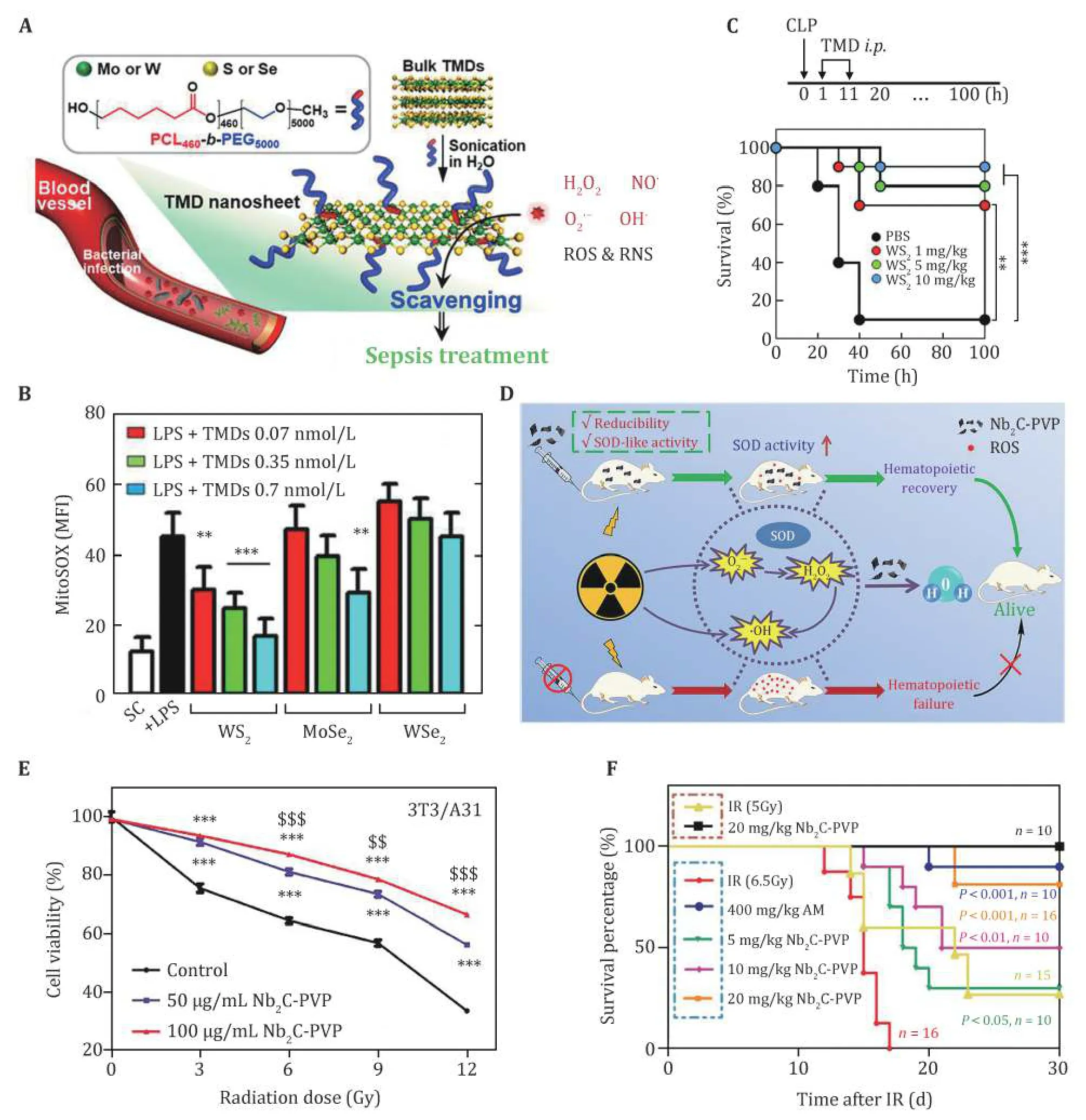
Fig. 4 TMCs nanosheets and MXenes scavenging activity. A Schematic diagram for the functionalization of TMD nanosheets and their ROS and RNS scavenging for sepsis treatment. B ROS and RNS levels in LPS-induced inflammatory BMDMs incubated with different TMD nanosheets. C 100 h survival rate of septic mice with treatment of 0, 1, 5, and 10 mg/kg of WS2. Reproduced with permission (Yim et al.2020). D Schematic illustration of Nb2C-PVP with SOD-like activity to reduce IR-induced damage. E Cell viability of 3T3/A31 cells after treatment with Nb2C-PVP suspension at varied concentrations. F Survival percentage of BALB/C mice under the radiation of sub-lethal TBI and lethal TBI with different pretreatments. Reproduced with permission (Ren et al. 2019)
2D metal-organic framework (MOF) nanosheetbased nanozyme
As a novel layered nanomaterial, 2D metal-organic framework (MOF) nanosheets come into spotlight owing to the abundant active sites on their surface or pore structure in contrast to traditional 3D MOF materials. Metalloporphyrins have already proven high similarity of their microstructure together with natural enzymes (Fenget al. 2012). Therefore, metalloporphyrin frameworks have been designed and established as biological oxidase-mimicking nanozymes for the catalytic activation of molecular oxygen.
In 2016, Wanget al. synthesized ultrathin bimetallic 2D Co-TCPP(Fe) ((Fe(III) tetra(4-carboxyphenyl)porphins chloride) nanosheets as a promising biosensor for H2O2detection (Fig. 5A) (Wanget al.2016). It is common knowledge that the iron-porphyrin derivative exhibits similar effects of hemoglobin.Inspired of the hemeprotein-like activity, researchers designed an electrochemical detection built on Co-TCPP(Fe). As expected, the glassy carbon electrode(GC)/(Co-TCPP(Fe))n(n= 1-6) electrodes exhibit noticeable reduction peak elucidating the reduction of H2O2, suggesting the hemeprotein-mimic activity. These results indicated that the catalytic activity of electrode exhibit a strong dependence of H2O2concentration,showing linear relationships between the H2O2concentration and current response with H2O2concentration ranging from 0.4 × 10-6mol/L to 50 ×10-6mol/L. Furthermore, this Co-TCPP(Fe)-enabled nanozyme biosensor can effectively offer the real-time detection of H2O2secreted from living cells (Fig. 5B).
Likewise, their group successfully mimicked enzyme triggering cascade reactions by synergistic cooperation of Au nanoparticles (NPs) and 2D Cu-TCPP(Fe)nanosheets (Huanget al. 2017). In this work, they elaborately prepared Au NPs/Cu-TCPP(Fe) hybrid nanosheets in which AuNPs function as oxidase-like nanozyme, while Cu-TCPP(Fe) is employed as peroxidase-mimic nanozyme (Fig. 5C). They constructed an artificial enzymatic cascade reaction system. Firstly, the hybrid nanozyme can first catalyze glucose to generate hydrogen peroxide. Secondly, the product H2O2can oxidize TMB to produce a blue-color reaction in the presence of peroxidase-like nanozyme.As depicted in Fig. 5D and 5E, a stronger light absorption at 652 nm demonstrated that the coupled nanozyme system is capable of initiating the TMB oxidation, and the results proved the occurrence of biomimetic cascade catalytic reaction. This study verified that the artificial enzymatic cascade reactions are of great application potential by integrating diverse nanomaterials with enzyme-like properties.
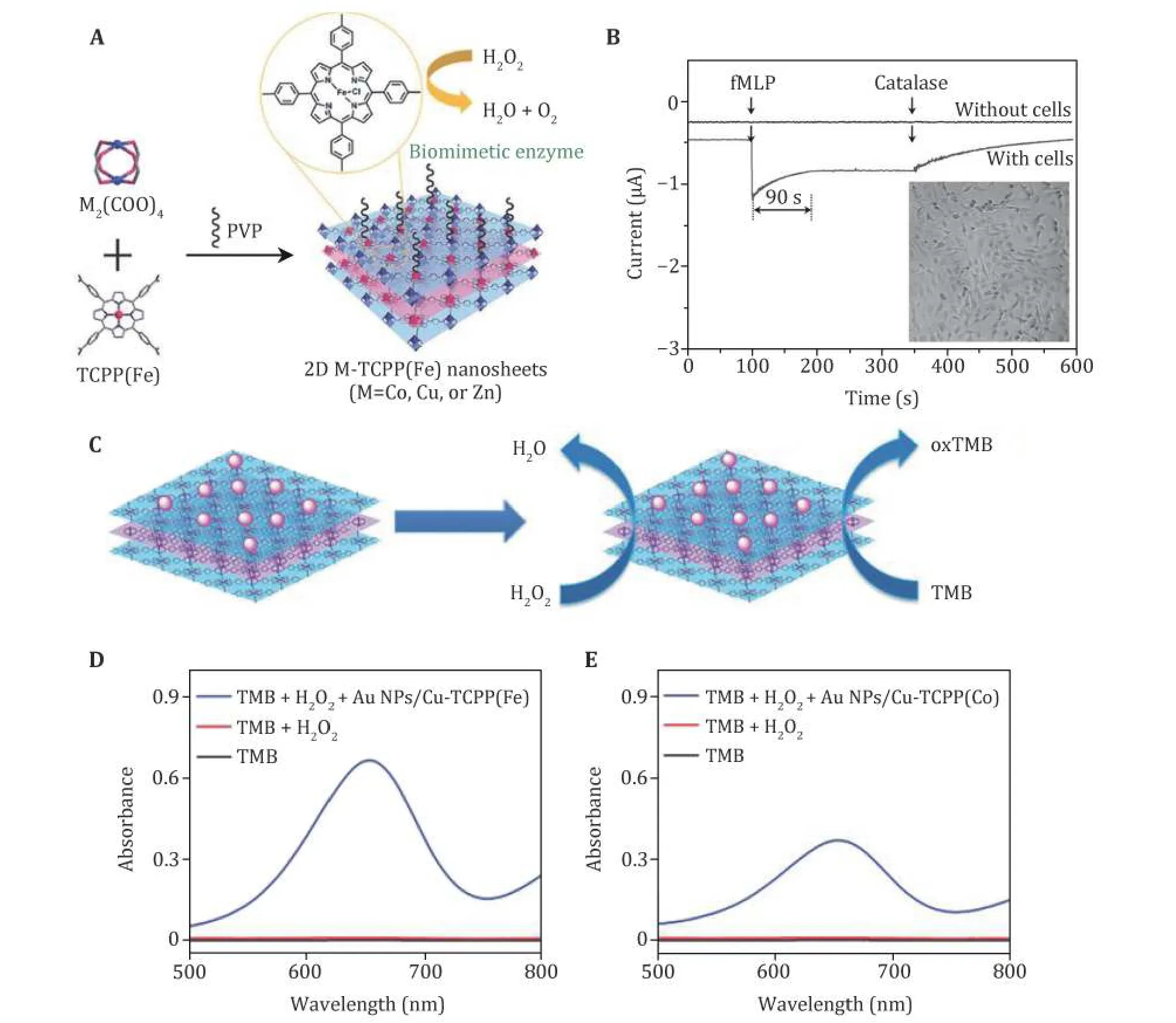
Fig. 5 2D MOF nanosheets for biosensing application. A Schematic illustration of the fabrication of 2D M-TCPP (Fe) nanosheets as biomimetic enzyme. B The real-time monitoring of H2O2 secreted by MDA-MB-231 cells. Reproduced with permission (Wang et al. 2016).C Schematic of AuNPs/Cu-TCPP(Fe) hybrid nanosheets catalyzing the cascade reactions. D, E The UV-Vis absorption spectra of different solutions. Reproduced with permission (Huang et al. 2017)
Other 2D families nanosheet-based nanozyme
In addition to the 2D nanomaterials with enzyme-like characteristics mentioned above, there are numerous 2D materials used as nanozymes for catalytic medicinerelated treatments. Niobium dieseline (NbSe2) is a kind of 2D transition metal selenides (TMSs) which holds great promise for electrical devices by virtue of its excellent superconductivity. In 2020, Miaoet al.pioneered the application of DNA-capped NbSe2as nanozyme in reactive oxygen and nitrogen species(RONS) elimination (Fig. 6A) (Miaoet al. 2020). As discussed above, RONS signaling molecules are inflammatory signaling molecule which can induce the secretion of inflammatory cytokines and then exacerbate inflammation. It is highly expected that NbSe2nanosheets possess the reaction activity with polar molecules, suggesting that the potential of nanosheets as anti-inflammatory nanodrug. As shown in Fig. 6B, NbSe2exhibits evident efficacy in antioxidative protection, while H2O2leads to massive cell apoptosis. Furthermore, these NbSe2nanosheets significantly down-regulated the inflammatory cytokines level in rear thigh inflammation mice,suggesting the excellent anti-inflammatory activityin vivo. Moreover, under the 808 nm laser irradiation, the NbSe2nanosheets exhibited favorable photothermal tumor eradication and PA imaging contrast enhancement function.
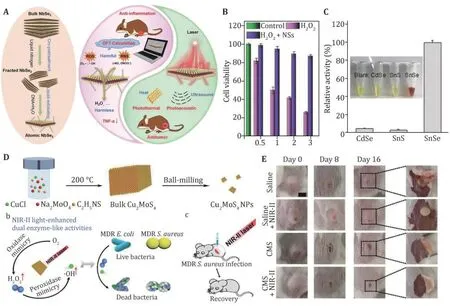
Fig. 6 2D materials mimic enzyme-catalyzed reactions. A Schematic illustration of NbSe2 nanosheets for anti-inflammation and lightinduced anti-cancer therapy. B Cell viability of HUVECs under H2O2 environment. Reproduced with permission (Miao et al. 2020). C The evaluation of dehydrogenase-like activity of different nanosheets, i.e., CdSe, SnS, SnSe. Reproduced with permission (Gao et al. 2020).D Schematic of NIR-II responsive Cu2MoS4 nanosheets of dual enzyme-like activities. E The photographs of MDR S. aureus-infected mice after different treatments. Reproduced with permission (Shan et al. 2020)
Dehydrogenase (e.g., malate dehydrogenase, NADH dehydrogenase and succinic dehydrogenase) is a class of vital enzymes that mediate oxidation-reduction biochemical reactions and play a key role in tricarboxylic acid (TCA) cycle (Spinelliet al. 2017).With the in-depth studies of disease mechanism,dehydrogenase has been found to associated with immune response and the progression of a great variety of diseases. For example, dehydrogenase may generate excessive ROS and cause oxidative stress in mitochondria, which triggers the inflammatory reaction. A representative study by Gaoet al. firstly presented that SnSe nanosheets feature dehydrogenase-like activity, proving a novel type of nanozyme for efficient bio-catalysis (Gaoet al. 2020).Colorimetry-based detection was employed to investigate the catalytic activities of SnSe nanosheets.Once receiving transferred hydrogen, the corresponding assay kits will display dramatic color reaction (Fig. 6C). As a result, SnSe exhibited strong ability of dehydrogenation in comparison with other similar 2D TMSs, indicating that the Sn elements exist the high catalytic effect in combination with selenium components. Given that SnSe nanosheets displayed enhanced and universal catalytic activity (>75%) in diverse reaction without the assistance of co-enzymes,it is highly expected that SnSe nanozyme will be further exploited for biomedical practices.
In the past decade, various nanomaterials as antibacterial agents have attracted considerable interests, which promote the exploration of potential antibacterial strategies that exploit different properties of materials (Xinet al. 2019). Catalytic medicine based on nanozymes paves a new way for bacterial infections.Aiming at multidrug-resistant (MDR) bacteria, Shanet al.proposed a second near-infrared window (NIR-II) light responsive nanozyme to combat multiple drug resistance (MDR)Escherichia coli(E. coli) and MDRStaphylococcus aureus(S. aureus) using Cu2MoS4nanoplates (CMS NPs) as an oxidase- and peroxidaselike catalyst whose activity can be modulated by NIR-II laser irradiation (Fig. 6D) (Shanet al. 2020). Cu2MoS4(CMS) is a neotype ternary layered TMC featuring high photothermal conversion efficiency (37.8%) and the catalytic ROS generation ability. More importantly, they found that the photothermal effect for hyperthermia facilitates ROS production to kill bacteria. Finally, a significant abscess and severe ulceration were identified in control groups showing the infection gradually aggravated without CMS NPs treatment (Fig. 6E).
CONCLUSIONS AND PERSPECTIVES
2D nanomaterials show great promise as substitutes of natural enzymes due to their intrinsic catalytic activity.Excitedly, the superior catalytic properties of nanozyme fit neatly to the catalytic strategy for many kinds of diseases treatment. This review briefly overviews recent advances in the design and development of nanozyme based on 2D materials focusing particularly on their biological applications including detection,anti-inflammation and anti-bacteria (Table 1).
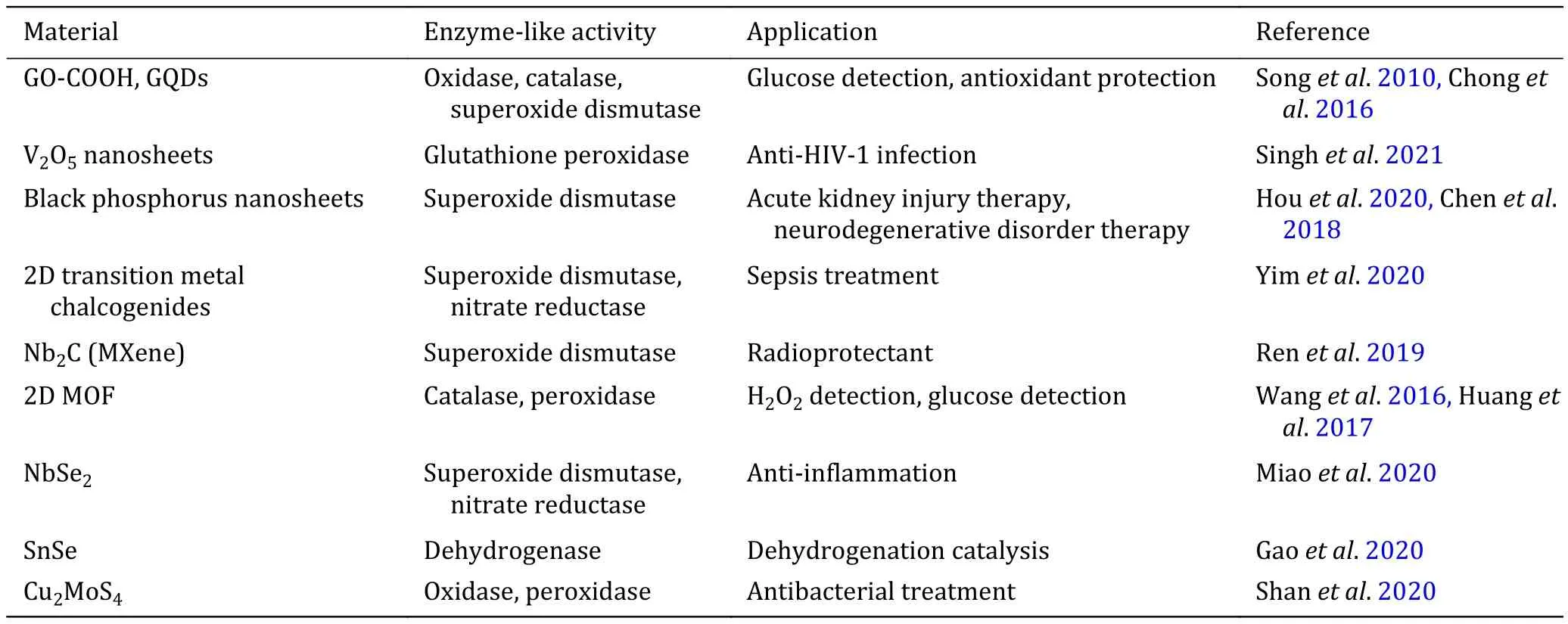
Table 1 Applications of two-dimensional materials-based nanozyme in biomedicine
During the past few years, there have been hundreds of literatures focused on nanozymes and a number of nanomaterials have been developed as nanozyme.Nevertheless, the area of 2D nanomaterials as nanozymes is still in its infancy. Compared to other non-2D nanozymes, 2D nanomaterials have their fascinating advantages thanking to the unique layered structure.
(1) The high specific surface areas enable the 2D nanomaterials with a high density of surface active sites,which is beneficial to enzyme-like catalytic reactions.
(2) Traditional inorganic enzyme-like nanomaterials have the unavoidable drawbacks such as poor chemical/thermal stabilities, single functionality and poor degradability. Excitedly, 2D nanomaterials possess desirable characteristics like facile modification and functionalization, tunable morphology/structure,plasticity, multivalent interactions, satisfactory biodegradation, and relatively high physiological stability, which endow 2D nanomaterials with great potential for further clinical applications.
(3) The unique inherent optoelectronic properties of 2D nanomaterials facilitate the implementation of stimuli-responsive multifunctional nanodrugs.
As a burgeoning field, the exact concept of nanozyme has not be put forward and it is urgent to establish evaluation standards for enzyme-like catalytic activity of a variety of nanozymes. Meanwhile, the catalytic mechanisms have to be comprehensively explored to allow more designs over the enzyme-like catalyst.Although extensive researches have demonstrated that SOD-like nanozymes are effective in treating ROS-related diseases, the mechanisms of treatment always elude explanation. It is urgent to thoroughly investigate the biological phenomena basing on molecular biology before applying nanozyme-drugs into human body.Moreover, when it comes to nanomedicinein vivoapplications, biocompatibility and biosafety are the eternal theme. Comprehensive and long-term bio-safety assessment are indispensable for 2D nanozyme in future clinical applications. Enzyme is a huge family, and thousands of enzymes have been found in the human body. In addition to several enzymes that have been already studied, the development of nanozymes mimicking more types of natural enzymes is needed,which may be a new opportunity to explore and treat intractable diseases. For 2D nanomaterials, we can take advantage of their other unique physicochemical properties to catalyze reactions more than just redox type reactions. It is believed that conditional-activated smart nanozyme that can convert its functions depending upon different diseases will be a hot topic in nanomedicine field. Given that, we believe that 2D nanomaterials will be a huge part of natural enzyme alternatives offering new opportunities for novel nanozymes with a board of applications in detection,diagnostics and catalytic therapy.
AcknowledgementsWe greatly acknowledge the National Natural Science Foundation of China (52002391 and 21835007),Key Research Program of Frontier Sciences, Chinese Academy of Sciences (ZDBS-LY-SLH029), China Postdoctoral Science Foundation (2019M660098), and Science Foundation for Youth Scholar of State Key Laboratory of High Performance Ceramics and Superfine Microstructures (SKL201906).
Compliance with Ethical Standards
Conflict of interestYanling You, Zhongmin Tang, Han Lin and Jianlin Shi declare that they have no conflict of interest.
Human and animal rights and informed consentThis article does not contain any studies with human or animal subjects performed by any of the authors.
Open AccessThis article is licensed under a Creative Commons Attribution 4.0 International License, which permits use,sharing, adaptation, distribution and reproduction in any medium or format, as long as you give appropriate credit to the original author(s) and the source, provide a link to the Creative Commons licence, and indicate if changes were made. The images or other third party material in this article are included in the article's Creative Commons licence, unless indicated otherwise in a credit line to the material. If material is not included in the article's Creative Commons licence and your intended use is not permitted by statutory regulation or exceeds the permitted use, you will need to obtain permission directly from the copyright holder. To view a copy of this licence, visit http://creativecommons.org/licenses/by/4.0/.
- Biophysics Reports的其它文章
- Latest developments on the mechanism of action of membrane disrupting peptides
- Research progress of STC2 in breast cancer
- What do we know about IL-6 in COVID-19 so far?
- How to use open-pFind in deep proteomics data analysis?—A protocol for rigorous identification and quantitation of peptides and proteins from mass spectrometry data
- Reduced graphene oxide membrane as supporting film for high-resolution cryo-EM
- Endogenous reactive oxygen species and nitric oxide have opposite roles in regulating HIF-1alpha expression in hypoxic astrocytes

